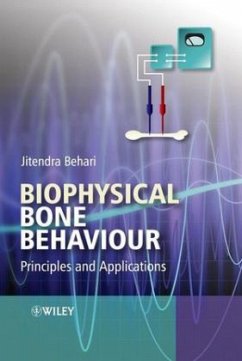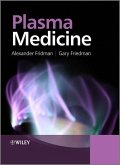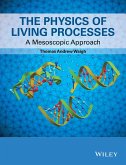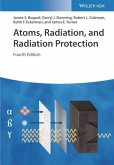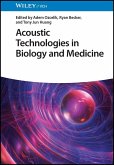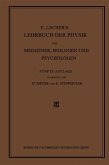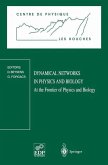- Gebundenes Buch
- Merkliste
- Auf die Merkliste
- Bewerten Bewerten
- Teilen
- Produkt teilen
- Produkterinnerung
- Produkterinnerung
Biophysical Bone Behaviour: Principles and Applications is the culmination of efforts to relate the biophysical phenomena in bone to bone growth and electrical behavior. Behari develops a bridge between physics and biology of bone leading to its clinical applications, primarily electro stimulations in fracture healing and osteoporosis. The book is based upon authors own research work and his review articles in the area, and updated with the latest research results. The first book dedicated to biophysical bone behavior Develops the relationship between the biophysics and biology of bone into an…mehr
Andere Kunden interessierten sich auch für
![Plasma Medicine Plasma Medicine]() Alexander FridmanPlasma Medicine105,99 €
Alexander FridmanPlasma Medicine105,99 €![The Physics of Living Processes The Physics of Living Processes]() Thomas Andrew WaighThe Physics of Living Processes101,99 €
Thomas Andrew WaighThe Physics of Living Processes101,99 €![Atoms, Radiation, and Radiation Protection Atoms, Radiation, and Radiation Protection]() James S. BogardAtoms, Radiation, and Radiation Protection129,00 €
James S. BogardAtoms, Radiation, and Radiation Protection129,00 €![Acoustic Technologies in Biology and Medicine Acoustic Technologies in Biology and Medicine]() Acoustic Technologies in Biology and Medicine113,99 €
Acoustic Technologies in Biology and Medicine113,99 €![E. Lecher¿s Lehrbuch der Physik für Mediziner, Biologen und Psychologen E. Lecher¿s Lehrbuch der Physik für Mediziner, Biologen und Psychologen]() Stefan MeyerE. Lecher¿s Lehrbuch der Physik für Mediziner, Biologen und Psychologen54,99 €
Stefan MeyerE. Lecher¿s Lehrbuch der Physik für Mediziner, Biologen und Psychologen54,99 €![Dynamical Networks in Physics and Biology Dynamical Networks in Physics and Biology]() Dynamical Networks in Physics and Biology83,99 €
Dynamical Networks in Physics and Biology83,99 €![Biophysical Ecology Biophysical Ecology]() D. M. GatesBiophysical Ecology42,99 €
D. M. GatesBiophysical Ecology42,99 €-
-
-
Biophysical Bone Behaviour: Principles and Applications is the culmination of efforts to relate the biophysical phenomena in bone to bone growth and electrical behavior. Behari develops a bridge between physics and biology of bone leading to its clinical applications, primarily electro stimulations in fracture healing and osteoporosis. The book is based upon authors own research work and his review articles in the area, and updated with the latest research results.
The first book dedicated to biophysical bone behavior
Develops the relationship between the biophysics and biology of bone into an integral unit
Spans basic biophysical studies and clinical applications
Links the various topics together to give readers a holistic understanding of the area
Presents all major research findings about bone and biophysics
Readers can access the full list of references at the companion website: www.wiley.com/go/behari
Hinweis: Dieser Artikel kann nur an eine deutsche Lieferadresse ausgeliefert werden.
The first book dedicated to biophysical bone behavior
Develops the relationship between the biophysics and biology of bone into an integral unit
Spans basic biophysical studies and clinical applications
Links the various topics together to give readers a holistic understanding of the area
Presents all major research findings about bone and biophysics
Readers can access the full list of references at the companion website: www.wiley.com/go/behari
Hinweis: Dieser Artikel kann nur an eine deutsche Lieferadresse ausgeliefert werden.
Produktdetails
- Produktdetails
- Verlag: Wiley & Sons
- 1. Auflage
- Seitenzahl: 416
- Erscheinungstermin: 1. September 2009
- Englisch
- Abmessung: 249mm x 175mm x 28mm
- Gewicht: 1000g
- ISBN-13: 9780470824009
- ISBN-10: 047082400X
- Artikelnr.: 26674663
- Herstellerkennzeichnung
- Libri GmbH
- Europaallee 1
- 36244 Bad Hersfeld
- gpsr@libri.de
- Verlag: Wiley & Sons
- 1. Auflage
- Seitenzahl: 416
- Erscheinungstermin: 1. September 2009
- Englisch
- Abmessung: 249mm x 175mm x 28mm
- Gewicht: 1000g
- ISBN-13: 9780470824009
- ISBN-10: 047082400X
- Artikelnr.: 26674663
- Herstellerkennzeichnung
- Libri GmbH
- Europaallee 1
- 36244 Bad Hersfeld
- gpsr@libri.de
Jitendra Behari, Jawaharlal Nehru University, New Delhi, India Jitendra Behari is a Professor of at the School of Environmental Sciences at Jawaharlal Nehru University, New Delhi. His main research interests are in the area of bioelectromagnetics, with emphasis on applications of microwaves and solid state physics techniques in environmental sciences, which includes soil moisture measurement. He has generated over one hundred research publications, four patents, and has developed several instruments in the electromagnetic field. Previous appointments include Adjunct Faculty at Michigan State University and three years with the biomedical engineering unit of IIT and AIIMS, New Delhi. He is a Fellow of the Institution of Electronics and Telecommunications Engineers and the Ultrasonic Society of India, and is a Senior Member of the IEEE. He has served on the executive bodies of the Biomedical Engineering Society of India, the Indian Society of Biomechanics, the Indian Physics Association, the Indian Vacuum Society and the Indian chapters of the IEEE's Electron Device and Microwave Theory and Techniques societies. Behari has also been a member of numerous other commissions and societies, including: Commission K of Union Radio Scientifique Internationale, IEEE Engineering in Medicine and Biology Society, the Electromagnetics Academy (USA), and the Indian Science Congress Association. He has in the past received Fulbright and University Grant Commission fellowships. Behari holds a PhD in Physics and was conferred an honorary D.Sc. in Bioelectromagnetics from Ansted University, UK at Penang, Malaysia.
Preface.
Acknowledgements.
About the Book.
1 Elements of Bone Biophysics.
1.1 Introduction.
1.2 Structural Aspect of Bone.
1.2.1 Elementary Constituents of Bone.
1.2.2 The Fibers.
1.2.3 Collagen Synthesis.
1.2.4 Bone Matrix (Inorganic Component).
1.3. Classification of Bone Tissues.
1.3.1 Compact Bone.
1.3.2 Fine Cancellous Bone.
1.3.3 Coarse Cancellous Bone.
1.4 Lamellation.
1.4.1 The Cement.
1.5 Role of Bone Water.
1.6 Bone Metabolism.
1.6.1 Ca and P Metabolism.
1.7 Osteoporosis.
1.8 Bone Cells.
1.8.1 Osteoblasts.
1.8.2 Osteoblast Differentiation.
1.8.3 Osteoclast.
1.8.4 Osteoclast Differentiation.
1.8.5 The Osteocytes.
1.8.6 Mathematical Formulation.
1.9 Bone Remodeling.
1.10 Biochemical Markers of Bone and Collagen.
1.11 Summary.
2 Piezoelectricity in Bone.
2.1 Introduction.
2.2 Piezoelectric Effect.
2.2.1 Properties Relating to Piezoelectricity.
2.3 Physical Concept of Piezoelectricity.
2.3.1 Piezoelectric Theory.
2.4 Sound Propagated in a Piezoelectric Medium.
2.5 Equivalent Single-Crystal Structure of Bone.
2.6 Piezoelectric Properties of Dry Compact Bones.
2.6.1 Piezoelectric Properties of Dry and Wet Collagens.
2.6.2 Measurement of Piezoelectricity in Bone.
2.7 Bone Structure and Piezoelectric Properties.
2.8 Piezoelectric Transducers.
2.8.1 Transducer Vibration.
2.8.2 Transverse-Effect Transducer.
2.9 Ferroelectricity in Bone.
2.9.1 Experimental Details.
2.10 Two-Phase Mineral-Filled Plastic Composites.
2.10.1 Material Properties.
2.10.2 Bone Mechanical Properties.
2.11 Mechanical Properties of Cancellous Bone: Microscopic View.
2.12 Ultrasound and Bone Behavior.
2.12.1 Biochemical Coupling.
2.13 Traveling Wave Characteristics.
2.14 Viscoelasticity in Bone.
2.15 Discussion.
3 Bioelectric Phenomena in Bone.
3.1 Macroscopic Stress-Generated Potentials of Moist Bone.
3.2 Mechanism of Biopotential Generation.
3.3 Stress-Generated Potentials (SGPs) in Bone.
3.4 Streaming Potentials and Currents of Normal Cortical Bone: Macroscopic
Approach.
3.4.1 Streaming Potential and Current Dependence on Bone Structure and
Composition: Macroscopic View.
3.5 Microscopic Potentials and Models of SP Generation in Bone.
3.6 Stress-Generated Fields of Trabecular Bone.
3.7 Biopotential and Electrostimulation in Bone.
3.7.1 Electrode Implantation.
3.7.2 Control Data.
3.7.3 Pulsating Fields.
3.7.4 DC Stimulation.
3.7.5 Electromagnetic Field (50 Hz) Stimulation Along with Radio Frequency
Field Coupling.
3.7.6 Continuous Fields.
3.7.7 Impedance Measurements.
3.8 Origin of Various Bioelectric Potentials in Bone.
4 Solid State Bone Behavior.
4.1 Introduction.
4.2 Electrical Conduction in Bone.
4.2.1 Bone as a Semiconductor.
4.2.2 Bone Dielectric Properties.
4.3 Microwave Conductivity in Bone.
4.4 Electret Phenomena.
4.4.1 Thermo Electret.
4.4.2 Electro Electret.
4.4.3 Magneto Electret.
4.5 Hall Effect in Bone.
4.5.1 Hall Effect, Hall Mobility and Drift Mobility.
4.5.2 Magnetic Field Dependence of the Hall Coefficient in Apatite.
4.6 Photovoltaic Effect.
4.7 PN Junction Phenomena in Bone.
4.7.1 Breakdown Phenomenon of PN Junction.
4.7.2 Behavior of the PN Junction Under IR and UV Conditions.
4.7.3 Photoelectromagnetic (PEM) Effect.
4.7.4 Life Time of Charge Carriers.
4.8 Bone Electrical Parameters in Microstrip Line Configuration.
4.8.1 Theoretical Formulation.
4.9 Bone Physical Properties and Ultrasonic Transducer.
5 Bioelectric Phenomena: Electrostimulation and Fracture Healing.
5.1 Introduction.
5.2 Biophysics of Fracture.
5.2.1 Mechanisms of Bone Fracture.
5.2.2 Mechanical Stimulation to Enhance Fracture Repair.
5.3 Bone Fracture Healing.
5.3.1 Histologic Fractures.
5.3.2 Growth Hormone (GH) Effect on Fracture Healing.
5.3.3 Biological Principles.
5.3.4 Cell Array Model for Repairing or Remodeling Bone.
5.4 Electromagnetic Field and Fracture Healing.
5.4.1 Methods in Bone Fracture Healing.
5.4.2 Stimulation by Constant Direct Current Sources.
5.4.3 Pulsed Electromagnetic Fields (PEMFs).
5.4.4 Inductive Coupling.
5.4.5 Capacitive Coupling.
5.4.6 Mechanism of Action.
5.4.7 Mechanism of PEMF Interaction at the Cellular Level.
5.4.8 Spatial Coherence.
5.4.9 Effects of EMFs on Signal Transduction in Bone.
5.4.10 The Biophysical Interaction Concept of Window.
5.4.11 Mechanisms for EMF Effects on Bone Signal Transduction.
5.5 Venous Pressure and Bone Formation.
5.6 Ultrasound and Bone Repair.
5.6.1 Ultrasonic Attenuation.
5.6.2 Measurements on Human Tibiae.
5.6.3 Measurements on Models.
5.7 SNR Analysis for EMF, US and SGP Signals.
5.7.1 Ununited Fractures.
5.8 Low Energy He-Ne Laser Irradiation and Bone Repair.
5.9 Electrostimulation of Osteoporosis.
5.10 Other Techniques: Use of Nanoparticles.
5.11 Possible Mechanism Involved in Osteoporosis.
6 Biophysical Parameters Affecting Osteoporosis.
6.1 Introduction.
6.1.1 Osteoporosis in Women.
6.1.2 Osteoporosis in Men.
6.1.3 Osteoporosis Types.
6.1.4 Spinal Cord Injury (SCI).
6.1.5 Effect of Microgravity.
6.1.6 Bone Loss.
6.1.7 Secondary Osteoporosis.
6.2 Senile and Postmenopausal Osteoporosis.
6.2.1 Type of Bone Pathogenesis.
6.2.2 Risk Factors for Fractures.
6.2.3 Fracture Risk Models.
6.3 Theoretical Analysis of Fracture Prediction by Distant BMD Measurement
Sites.
6.4 Markers of Osteoporosis.
6.4.1 Structural Changes.
6.4.2 Biophysical Parameters.
6.5 Osteoporosis Interventions.
6.6 Role of Estrogen.
6.6.1 Steroid-Induced Osteoporosis.
6.6.2 Impact of HRT on Osteoporotic Fractures.
6.6.3 Role of Estrogen-Progesterone Combination.
6.7 Glucocorticoid.
6.8 Vitamin D and Osteoporosis.
6.9 Role of Calcitonin.
6.10 Calcitonin and Glucocorticoids.
6.11 Parathyroid Hormone (PTH).
6.12 Role of Prostaglandins.
6.13 Thiazide Diuretics (TD).
6.14 Effects of Fluoride.
6.15 Role of Growth Hormone (GH).
6.16 Cholesterol.
6.17 Interleukin 1 (IL-1).
6.18 Bisphosphonates (BPs).
6.19 Adipocyte Hormones.
6.20 Mechanism of Action of Antiresorptive Agents.
6.21 Genetic Studies of Osteoporosis.
6.22 Nutritional Aspects in Osteoporosis.
6.22.1 Biochemical Markers.
6.22.2 Salt Intake.
6.22.3 Calcium.
6.22.4 Protein.
6.22.5 Lactose.
6.22.6 Phosphorous.
6.22.7 Lymphotoxin.
6.22.8 Dietary Fiber, Oxalic Acid and Phytic Acid.
6.22.9 Alcohol.
6.22.10 Caffeine.
6.22.11 Other Factors.
6.23 Osteoporosis: Prevention and Treatment.
6.23.1 Gene Therapy.
6.24 Non-invasive Techniques.
6.24.1 Electrical Stimulation and Osteoporosis.
6.24.2 Ultrasonic Methods.
6.25 Conclusion.
7 Non-Invasive Techniques used to Measure Osteoporosis.
7.1 Introduction.
7.2 Measurement of the Mineral Content.
7.2.1 Clinical Measurements.
7.2.2 Calibration and Accuracy.
7.2.3 Limitations.
7.2.4 Singh Index.
7.3 Bone Densitometric Methods.
7.3.1 Radiographic Methods.
7.4 X-ray Tomography.
7.5 Skeleton Roentgenology.
7.6 Metacarpal Index.
7.7 Analysis of Radiographic Methods.
7.8 Direct Photon Absorption Method.
7.8.1 Theory.
7.8.2 Clinical Applications.
7.9 Limitations of the Method.
7.10 Dual-Photon Absorptiometry (DPA).
7.10.1 Theoretical Background.
7.10.2 Procedure.
7.10.3 Nature of Attenuation.
7.10.4 Reproducibility.
7.11 Computed Tomography (CT).
7.11.1 Instrumentation and Clinical Procedure.
7.11.2 Quantitative Computed Tomography (QCT).
7.12 Modification of CT Methods.
7.12.1 CT Methods: Benefits and Risks.
7.12.2 Discussion.
7.13 Methods Based on Compton Scattering.
7.13.1 Technique.
7.14 Coherent and Compton Scattering.
7.14.1 Clinical Applications.
7.15 Dual Energy Technique.
7.15.1 Dual Energy X-ray Absorptiometry (DEXA).
7.15.2 Theoretical Formulation and Instrumentation.
7.15.3 Technical Details.
7.15.4 Simulation Studies.
7.16 Neutron Activation Analysis.
7.16.1 Technique.
7.16.2 Site Choice.
7.16.3 Dose.
7.16.4 Limitations.
7.17 Infrasound Method for Bone Mass Measurements.
7.17.1 The Ultrasonic Measurement: Concepts and Technique.
7.17.2 Stress Wave Propagation in Bone and its Clinical Use.
7.17.3 Measurement of Bone Parameters.
7.17.4 Ultrasound System.
7.17.5 Procedure for Obtaining Patient Data.
7.17.6 Analysis of Patient Data.
7.17.7 Verification of the In Vivo Bone Parameters.
7.18 Other Techniques.
7.18.1 Magnetic Resonance Imaging (MRI).
7.19 Relative Advantages and Disadvantages of the Various Techniques.
References.
Index.
Acknowledgements.
About the Book.
1 Elements of Bone Biophysics.
1.1 Introduction.
1.2 Structural Aspect of Bone.
1.2.1 Elementary Constituents of Bone.
1.2.2 The Fibers.
1.2.3 Collagen Synthesis.
1.2.4 Bone Matrix (Inorganic Component).
1.3. Classification of Bone Tissues.
1.3.1 Compact Bone.
1.3.2 Fine Cancellous Bone.
1.3.3 Coarse Cancellous Bone.
1.4 Lamellation.
1.4.1 The Cement.
1.5 Role of Bone Water.
1.6 Bone Metabolism.
1.6.1 Ca and P Metabolism.
1.7 Osteoporosis.
1.8 Bone Cells.
1.8.1 Osteoblasts.
1.8.2 Osteoblast Differentiation.
1.8.3 Osteoclast.
1.8.4 Osteoclast Differentiation.
1.8.5 The Osteocytes.
1.8.6 Mathematical Formulation.
1.9 Bone Remodeling.
1.10 Biochemical Markers of Bone and Collagen.
1.11 Summary.
2 Piezoelectricity in Bone.
2.1 Introduction.
2.2 Piezoelectric Effect.
2.2.1 Properties Relating to Piezoelectricity.
2.3 Physical Concept of Piezoelectricity.
2.3.1 Piezoelectric Theory.
2.4 Sound Propagated in a Piezoelectric Medium.
2.5 Equivalent Single-Crystal Structure of Bone.
2.6 Piezoelectric Properties of Dry Compact Bones.
2.6.1 Piezoelectric Properties of Dry and Wet Collagens.
2.6.2 Measurement of Piezoelectricity in Bone.
2.7 Bone Structure and Piezoelectric Properties.
2.8 Piezoelectric Transducers.
2.8.1 Transducer Vibration.
2.8.2 Transverse-Effect Transducer.
2.9 Ferroelectricity in Bone.
2.9.1 Experimental Details.
2.10 Two-Phase Mineral-Filled Plastic Composites.
2.10.1 Material Properties.
2.10.2 Bone Mechanical Properties.
2.11 Mechanical Properties of Cancellous Bone: Microscopic View.
2.12 Ultrasound and Bone Behavior.
2.12.1 Biochemical Coupling.
2.13 Traveling Wave Characteristics.
2.14 Viscoelasticity in Bone.
2.15 Discussion.
3 Bioelectric Phenomena in Bone.
3.1 Macroscopic Stress-Generated Potentials of Moist Bone.
3.2 Mechanism of Biopotential Generation.
3.3 Stress-Generated Potentials (SGPs) in Bone.
3.4 Streaming Potentials and Currents of Normal Cortical Bone: Macroscopic
Approach.
3.4.1 Streaming Potential and Current Dependence on Bone Structure and
Composition: Macroscopic View.
3.5 Microscopic Potentials and Models of SP Generation in Bone.
3.6 Stress-Generated Fields of Trabecular Bone.
3.7 Biopotential and Electrostimulation in Bone.
3.7.1 Electrode Implantation.
3.7.2 Control Data.
3.7.3 Pulsating Fields.
3.7.4 DC Stimulation.
3.7.5 Electromagnetic Field (50 Hz) Stimulation Along with Radio Frequency
Field Coupling.
3.7.6 Continuous Fields.
3.7.7 Impedance Measurements.
3.8 Origin of Various Bioelectric Potentials in Bone.
4 Solid State Bone Behavior.
4.1 Introduction.
4.2 Electrical Conduction in Bone.
4.2.1 Bone as a Semiconductor.
4.2.2 Bone Dielectric Properties.
4.3 Microwave Conductivity in Bone.
4.4 Electret Phenomena.
4.4.1 Thermo Electret.
4.4.2 Electro Electret.
4.4.3 Magneto Electret.
4.5 Hall Effect in Bone.
4.5.1 Hall Effect, Hall Mobility and Drift Mobility.
4.5.2 Magnetic Field Dependence of the Hall Coefficient in Apatite.
4.6 Photovoltaic Effect.
4.7 PN Junction Phenomena in Bone.
4.7.1 Breakdown Phenomenon of PN Junction.
4.7.2 Behavior of the PN Junction Under IR and UV Conditions.
4.7.3 Photoelectromagnetic (PEM) Effect.
4.7.4 Life Time of Charge Carriers.
4.8 Bone Electrical Parameters in Microstrip Line Configuration.
4.8.1 Theoretical Formulation.
4.9 Bone Physical Properties and Ultrasonic Transducer.
5 Bioelectric Phenomena: Electrostimulation and Fracture Healing.
5.1 Introduction.
5.2 Biophysics of Fracture.
5.2.1 Mechanisms of Bone Fracture.
5.2.2 Mechanical Stimulation to Enhance Fracture Repair.
5.3 Bone Fracture Healing.
5.3.1 Histologic Fractures.
5.3.2 Growth Hormone (GH) Effect on Fracture Healing.
5.3.3 Biological Principles.
5.3.4 Cell Array Model for Repairing or Remodeling Bone.
5.4 Electromagnetic Field and Fracture Healing.
5.4.1 Methods in Bone Fracture Healing.
5.4.2 Stimulation by Constant Direct Current Sources.
5.4.3 Pulsed Electromagnetic Fields (PEMFs).
5.4.4 Inductive Coupling.
5.4.5 Capacitive Coupling.
5.4.6 Mechanism of Action.
5.4.7 Mechanism of PEMF Interaction at the Cellular Level.
5.4.8 Spatial Coherence.
5.4.9 Effects of EMFs on Signal Transduction in Bone.
5.4.10 The Biophysical Interaction Concept of Window.
5.4.11 Mechanisms for EMF Effects on Bone Signal Transduction.
5.5 Venous Pressure and Bone Formation.
5.6 Ultrasound and Bone Repair.
5.6.1 Ultrasonic Attenuation.
5.6.2 Measurements on Human Tibiae.
5.6.3 Measurements on Models.
5.7 SNR Analysis for EMF, US and SGP Signals.
5.7.1 Ununited Fractures.
5.8 Low Energy He-Ne Laser Irradiation and Bone Repair.
5.9 Electrostimulation of Osteoporosis.
5.10 Other Techniques: Use of Nanoparticles.
5.11 Possible Mechanism Involved in Osteoporosis.
6 Biophysical Parameters Affecting Osteoporosis.
6.1 Introduction.
6.1.1 Osteoporosis in Women.
6.1.2 Osteoporosis in Men.
6.1.3 Osteoporosis Types.
6.1.4 Spinal Cord Injury (SCI).
6.1.5 Effect of Microgravity.
6.1.6 Bone Loss.
6.1.7 Secondary Osteoporosis.
6.2 Senile and Postmenopausal Osteoporosis.
6.2.1 Type of Bone Pathogenesis.
6.2.2 Risk Factors for Fractures.
6.2.3 Fracture Risk Models.
6.3 Theoretical Analysis of Fracture Prediction by Distant BMD Measurement
Sites.
6.4 Markers of Osteoporosis.
6.4.1 Structural Changes.
6.4.2 Biophysical Parameters.
6.5 Osteoporosis Interventions.
6.6 Role of Estrogen.
6.6.1 Steroid-Induced Osteoporosis.
6.6.2 Impact of HRT on Osteoporotic Fractures.
6.6.3 Role of Estrogen-Progesterone Combination.
6.7 Glucocorticoid.
6.8 Vitamin D and Osteoporosis.
6.9 Role of Calcitonin.
6.10 Calcitonin and Glucocorticoids.
6.11 Parathyroid Hormone (PTH).
6.12 Role of Prostaglandins.
6.13 Thiazide Diuretics (TD).
6.14 Effects of Fluoride.
6.15 Role of Growth Hormone (GH).
6.16 Cholesterol.
6.17 Interleukin 1 (IL-1).
6.18 Bisphosphonates (BPs).
6.19 Adipocyte Hormones.
6.20 Mechanism of Action of Antiresorptive Agents.
6.21 Genetic Studies of Osteoporosis.
6.22 Nutritional Aspects in Osteoporosis.
6.22.1 Biochemical Markers.
6.22.2 Salt Intake.
6.22.3 Calcium.
6.22.4 Protein.
6.22.5 Lactose.
6.22.6 Phosphorous.
6.22.7 Lymphotoxin.
6.22.8 Dietary Fiber, Oxalic Acid and Phytic Acid.
6.22.9 Alcohol.
6.22.10 Caffeine.
6.22.11 Other Factors.
6.23 Osteoporosis: Prevention and Treatment.
6.23.1 Gene Therapy.
6.24 Non-invasive Techniques.
6.24.1 Electrical Stimulation and Osteoporosis.
6.24.2 Ultrasonic Methods.
6.25 Conclusion.
7 Non-Invasive Techniques used to Measure Osteoporosis.
7.1 Introduction.
7.2 Measurement of the Mineral Content.
7.2.1 Clinical Measurements.
7.2.2 Calibration and Accuracy.
7.2.3 Limitations.
7.2.4 Singh Index.
7.3 Bone Densitometric Methods.
7.3.1 Radiographic Methods.
7.4 X-ray Tomography.
7.5 Skeleton Roentgenology.
7.6 Metacarpal Index.
7.7 Analysis of Radiographic Methods.
7.8 Direct Photon Absorption Method.
7.8.1 Theory.
7.8.2 Clinical Applications.
7.9 Limitations of the Method.
7.10 Dual-Photon Absorptiometry (DPA).
7.10.1 Theoretical Background.
7.10.2 Procedure.
7.10.3 Nature of Attenuation.
7.10.4 Reproducibility.
7.11 Computed Tomography (CT).
7.11.1 Instrumentation and Clinical Procedure.
7.11.2 Quantitative Computed Tomography (QCT).
7.12 Modification of CT Methods.
7.12.1 CT Methods: Benefits and Risks.
7.12.2 Discussion.
7.13 Methods Based on Compton Scattering.
7.13.1 Technique.
7.14 Coherent and Compton Scattering.
7.14.1 Clinical Applications.
7.15 Dual Energy Technique.
7.15.1 Dual Energy X-ray Absorptiometry (DEXA).
7.15.2 Theoretical Formulation and Instrumentation.
7.15.3 Technical Details.
7.15.4 Simulation Studies.
7.16 Neutron Activation Analysis.
7.16.1 Technique.
7.16.2 Site Choice.
7.16.3 Dose.
7.16.4 Limitations.
7.17 Infrasound Method for Bone Mass Measurements.
7.17.1 The Ultrasonic Measurement: Concepts and Technique.
7.17.2 Stress Wave Propagation in Bone and its Clinical Use.
7.17.3 Measurement of Bone Parameters.
7.17.4 Ultrasound System.
7.17.5 Procedure for Obtaining Patient Data.
7.17.6 Analysis of Patient Data.
7.17.7 Verification of the In Vivo Bone Parameters.
7.18 Other Techniques.
7.18.1 Magnetic Resonance Imaging (MRI).
7.19 Relative Advantages and Disadvantages of the Various Techniques.
References.
Index.
Preface.
Acknowledgements.
About the Book.
1 Elements of Bone Biophysics.
1.1 Introduction.
1.2 Structural Aspect of Bone.
1.2.1 Elementary Constituents of Bone.
1.2.2 The Fibers.
1.2.3 Collagen Synthesis.
1.2.4 Bone Matrix (Inorganic Component).
1.3. Classification of Bone Tissues.
1.3.1 Compact Bone.
1.3.2 Fine Cancellous Bone.
1.3.3 Coarse Cancellous Bone.
1.4 Lamellation.
1.4.1 The Cement.
1.5 Role of Bone Water.
1.6 Bone Metabolism.
1.6.1 Ca and P Metabolism.
1.7 Osteoporosis.
1.8 Bone Cells.
1.8.1 Osteoblasts.
1.8.2 Osteoblast Differentiation.
1.8.3 Osteoclast.
1.8.4 Osteoclast Differentiation.
1.8.5 The Osteocytes.
1.8.6 Mathematical Formulation.
1.9 Bone Remodeling.
1.10 Biochemical Markers of Bone and Collagen.
1.11 Summary.
2 Piezoelectricity in Bone.
2.1 Introduction.
2.2 Piezoelectric Effect.
2.2.1 Properties Relating to Piezoelectricity.
2.3 Physical Concept of Piezoelectricity.
2.3.1 Piezoelectric Theory.
2.4 Sound Propagated in a Piezoelectric Medium.
2.5 Equivalent Single-Crystal Structure of Bone.
2.6 Piezoelectric Properties of Dry Compact Bones.
2.6.1 Piezoelectric Properties of Dry and Wet Collagens.
2.6.2 Measurement of Piezoelectricity in Bone.
2.7 Bone Structure and Piezoelectric Properties.
2.8 Piezoelectric Transducers.
2.8.1 Transducer Vibration.
2.8.2 Transverse-Effect Transducer.
2.9 Ferroelectricity in Bone.
2.9.1 Experimental Details.
2.10 Two-Phase Mineral-Filled Plastic Composites.
2.10.1 Material Properties.
2.10.2 Bone Mechanical Properties.
2.11 Mechanical Properties of Cancellous Bone: Microscopic View.
2.12 Ultrasound and Bone Behavior.
2.12.1 Biochemical Coupling.
2.13 Traveling Wave Characteristics.
2.14 Viscoelasticity in Bone.
2.15 Discussion.
3 Bioelectric Phenomena in Bone.
3.1 Macroscopic Stress-Generated Potentials of Moist Bone.
3.2 Mechanism of Biopotential Generation.
3.3 Stress-Generated Potentials (SGPs) in Bone.
3.4 Streaming Potentials and Currents of Normal Cortical Bone: Macroscopic
Approach.
3.4.1 Streaming Potential and Current Dependence on Bone Structure and
Composition: Macroscopic View.
3.5 Microscopic Potentials and Models of SP Generation in Bone.
3.6 Stress-Generated Fields of Trabecular Bone.
3.7 Biopotential and Electrostimulation in Bone.
3.7.1 Electrode Implantation.
3.7.2 Control Data.
3.7.3 Pulsating Fields.
3.7.4 DC Stimulation.
3.7.5 Electromagnetic Field (50 Hz) Stimulation Along with Radio Frequency
Field Coupling.
3.7.6 Continuous Fields.
3.7.7 Impedance Measurements.
3.8 Origin of Various Bioelectric Potentials in Bone.
4 Solid State Bone Behavior.
4.1 Introduction.
4.2 Electrical Conduction in Bone.
4.2.1 Bone as a Semiconductor.
4.2.2 Bone Dielectric Properties.
4.3 Microwave Conductivity in Bone.
4.4 Electret Phenomena.
4.4.1 Thermo Electret.
4.4.2 Electro Electret.
4.4.3 Magneto Electret.
4.5 Hall Effect in Bone.
4.5.1 Hall Effect, Hall Mobility and Drift Mobility.
4.5.2 Magnetic Field Dependence of the Hall Coefficient in Apatite.
4.6 Photovoltaic Effect.
4.7 PN Junction Phenomena in Bone.
4.7.1 Breakdown Phenomenon of PN Junction.
4.7.2 Behavior of the PN Junction Under IR and UV Conditions.
4.7.3 Photoelectromagnetic (PEM) Effect.
4.7.4 Life Time of Charge Carriers.
4.8 Bone Electrical Parameters in Microstrip Line Configuration.
4.8.1 Theoretical Formulation.
4.9 Bone Physical Properties and Ultrasonic Transducer.
5 Bioelectric Phenomena: Electrostimulation and Fracture Healing.
5.1 Introduction.
5.2 Biophysics of Fracture.
5.2.1 Mechanisms of Bone Fracture.
5.2.2 Mechanical Stimulation to Enhance Fracture Repair.
5.3 Bone Fracture Healing.
5.3.1 Histologic Fractures.
5.3.2 Growth Hormone (GH) Effect on Fracture Healing.
5.3.3 Biological Principles.
5.3.4 Cell Array Model for Repairing or Remodeling Bone.
5.4 Electromagnetic Field and Fracture Healing.
5.4.1 Methods in Bone Fracture Healing.
5.4.2 Stimulation by Constant Direct Current Sources.
5.4.3 Pulsed Electromagnetic Fields (PEMFs).
5.4.4 Inductive Coupling.
5.4.5 Capacitive Coupling.
5.4.6 Mechanism of Action.
5.4.7 Mechanism of PEMF Interaction at the Cellular Level.
5.4.8 Spatial Coherence.
5.4.9 Effects of EMFs on Signal Transduction in Bone.
5.4.10 The Biophysical Interaction Concept of Window.
5.4.11 Mechanisms for EMF Effects on Bone Signal Transduction.
5.5 Venous Pressure and Bone Formation.
5.6 Ultrasound and Bone Repair.
5.6.1 Ultrasonic Attenuation.
5.6.2 Measurements on Human Tibiae.
5.6.3 Measurements on Models.
5.7 SNR Analysis for EMF, US and SGP Signals.
5.7.1 Ununited Fractures.
5.8 Low Energy He-Ne Laser Irradiation and Bone Repair.
5.9 Electrostimulation of Osteoporosis.
5.10 Other Techniques: Use of Nanoparticles.
5.11 Possible Mechanism Involved in Osteoporosis.
6 Biophysical Parameters Affecting Osteoporosis.
6.1 Introduction.
6.1.1 Osteoporosis in Women.
6.1.2 Osteoporosis in Men.
6.1.3 Osteoporosis Types.
6.1.4 Spinal Cord Injury (SCI).
6.1.5 Effect of Microgravity.
6.1.6 Bone Loss.
6.1.7 Secondary Osteoporosis.
6.2 Senile and Postmenopausal Osteoporosis.
6.2.1 Type of Bone Pathogenesis.
6.2.2 Risk Factors for Fractures.
6.2.3 Fracture Risk Models.
6.3 Theoretical Analysis of Fracture Prediction by Distant BMD Measurement
Sites.
6.4 Markers of Osteoporosis.
6.4.1 Structural Changes.
6.4.2 Biophysical Parameters.
6.5 Osteoporosis Interventions.
6.6 Role of Estrogen.
6.6.1 Steroid-Induced Osteoporosis.
6.6.2 Impact of HRT on Osteoporotic Fractures.
6.6.3 Role of Estrogen-Progesterone Combination.
6.7 Glucocorticoid.
6.8 Vitamin D and Osteoporosis.
6.9 Role of Calcitonin.
6.10 Calcitonin and Glucocorticoids.
6.11 Parathyroid Hormone (PTH).
6.12 Role of Prostaglandins.
6.13 Thiazide Diuretics (TD).
6.14 Effects of Fluoride.
6.15 Role of Growth Hormone (GH).
6.16 Cholesterol.
6.17 Interleukin 1 (IL-1).
6.18 Bisphosphonates (BPs).
6.19 Adipocyte Hormones.
6.20 Mechanism of Action of Antiresorptive Agents.
6.21 Genetic Studies of Osteoporosis.
6.22 Nutritional Aspects in Osteoporosis.
6.22.1 Biochemical Markers.
6.22.2 Salt Intake.
6.22.3 Calcium.
6.22.4 Protein.
6.22.5 Lactose.
6.22.6 Phosphorous.
6.22.7 Lymphotoxin.
6.22.8 Dietary Fiber, Oxalic Acid and Phytic Acid.
6.22.9 Alcohol.
6.22.10 Caffeine.
6.22.11 Other Factors.
6.23 Osteoporosis: Prevention and Treatment.
6.23.1 Gene Therapy.
6.24 Non-invasive Techniques.
6.24.1 Electrical Stimulation and Osteoporosis.
6.24.2 Ultrasonic Methods.
6.25 Conclusion.
7 Non-Invasive Techniques used to Measure Osteoporosis.
7.1 Introduction.
7.2 Measurement of the Mineral Content.
7.2.1 Clinical Measurements.
7.2.2 Calibration and Accuracy.
7.2.3 Limitations.
7.2.4 Singh Index.
7.3 Bone Densitometric Methods.
7.3.1 Radiographic Methods.
7.4 X-ray Tomography.
7.5 Skeleton Roentgenology.
7.6 Metacarpal Index.
7.7 Analysis of Radiographic Methods.
7.8 Direct Photon Absorption Method.
7.8.1 Theory.
7.8.2 Clinical Applications.
7.9 Limitations of the Method.
7.10 Dual-Photon Absorptiometry (DPA).
7.10.1 Theoretical Background.
7.10.2 Procedure.
7.10.3 Nature of Attenuation.
7.10.4 Reproducibility.
7.11 Computed Tomography (CT).
7.11.1 Instrumentation and Clinical Procedure.
7.11.2 Quantitative Computed Tomography (QCT).
7.12 Modification of CT Methods.
7.12.1 CT Methods: Benefits and Risks.
7.12.2 Discussion.
7.13 Methods Based on Compton Scattering.
7.13.1 Technique.
7.14 Coherent and Compton Scattering.
7.14.1 Clinical Applications.
7.15 Dual Energy Technique.
7.15.1 Dual Energy X-ray Absorptiometry (DEXA).
7.15.2 Theoretical Formulation and Instrumentation.
7.15.3 Technical Details.
7.15.4 Simulation Studies.
7.16 Neutron Activation Analysis.
7.16.1 Technique.
7.16.2 Site Choice.
7.16.3 Dose.
7.16.4 Limitations.
7.17 Infrasound Method for Bone Mass Measurements.
7.17.1 The Ultrasonic Measurement: Concepts and Technique.
7.17.2 Stress Wave Propagation in Bone and its Clinical Use.
7.17.3 Measurement of Bone Parameters.
7.17.4 Ultrasound System.
7.17.5 Procedure for Obtaining Patient Data.
7.17.6 Analysis of Patient Data.
7.17.7 Verification of the In Vivo Bone Parameters.
7.18 Other Techniques.
7.18.1 Magnetic Resonance Imaging (MRI).
7.19 Relative Advantages and Disadvantages of the Various Techniques.
References.
Index.
Acknowledgements.
About the Book.
1 Elements of Bone Biophysics.
1.1 Introduction.
1.2 Structural Aspect of Bone.
1.2.1 Elementary Constituents of Bone.
1.2.2 The Fibers.
1.2.3 Collagen Synthesis.
1.2.4 Bone Matrix (Inorganic Component).
1.3. Classification of Bone Tissues.
1.3.1 Compact Bone.
1.3.2 Fine Cancellous Bone.
1.3.3 Coarse Cancellous Bone.
1.4 Lamellation.
1.4.1 The Cement.
1.5 Role of Bone Water.
1.6 Bone Metabolism.
1.6.1 Ca and P Metabolism.
1.7 Osteoporosis.
1.8 Bone Cells.
1.8.1 Osteoblasts.
1.8.2 Osteoblast Differentiation.
1.8.3 Osteoclast.
1.8.4 Osteoclast Differentiation.
1.8.5 The Osteocytes.
1.8.6 Mathematical Formulation.
1.9 Bone Remodeling.
1.10 Biochemical Markers of Bone and Collagen.
1.11 Summary.
2 Piezoelectricity in Bone.
2.1 Introduction.
2.2 Piezoelectric Effect.
2.2.1 Properties Relating to Piezoelectricity.
2.3 Physical Concept of Piezoelectricity.
2.3.1 Piezoelectric Theory.
2.4 Sound Propagated in a Piezoelectric Medium.
2.5 Equivalent Single-Crystal Structure of Bone.
2.6 Piezoelectric Properties of Dry Compact Bones.
2.6.1 Piezoelectric Properties of Dry and Wet Collagens.
2.6.2 Measurement of Piezoelectricity in Bone.
2.7 Bone Structure and Piezoelectric Properties.
2.8 Piezoelectric Transducers.
2.8.1 Transducer Vibration.
2.8.2 Transverse-Effect Transducer.
2.9 Ferroelectricity in Bone.
2.9.1 Experimental Details.
2.10 Two-Phase Mineral-Filled Plastic Composites.
2.10.1 Material Properties.
2.10.2 Bone Mechanical Properties.
2.11 Mechanical Properties of Cancellous Bone: Microscopic View.
2.12 Ultrasound and Bone Behavior.
2.12.1 Biochemical Coupling.
2.13 Traveling Wave Characteristics.
2.14 Viscoelasticity in Bone.
2.15 Discussion.
3 Bioelectric Phenomena in Bone.
3.1 Macroscopic Stress-Generated Potentials of Moist Bone.
3.2 Mechanism of Biopotential Generation.
3.3 Stress-Generated Potentials (SGPs) in Bone.
3.4 Streaming Potentials and Currents of Normal Cortical Bone: Macroscopic
Approach.
3.4.1 Streaming Potential and Current Dependence on Bone Structure and
Composition: Macroscopic View.
3.5 Microscopic Potentials and Models of SP Generation in Bone.
3.6 Stress-Generated Fields of Trabecular Bone.
3.7 Biopotential and Electrostimulation in Bone.
3.7.1 Electrode Implantation.
3.7.2 Control Data.
3.7.3 Pulsating Fields.
3.7.4 DC Stimulation.
3.7.5 Electromagnetic Field (50 Hz) Stimulation Along with Radio Frequency
Field Coupling.
3.7.6 Continuous Fields.
3.7.7 Impedance Measurements.
3.8 Origin of Various Bioelectric Potentials in Bone.
4 Solid State Bone Behavior.
4.1 Introduction.
4.2 Electrical Conduction in Bone.
4.2.1 Bone as a Semiconductor.
4.2.2 Bone Dielectric Properties.
4.3 Microwave Conductivity in Bone.
4.4 Electret Phenomena.
4.4.1 Thermo Electret.
4.4.2 Electro Electret.
4.4.3 Magneto Electret.
4.5 Hall Effect in Bone.
4.5.1 Hall Effect, Hall Mobility and Drift Mobility.
4.5.2 Magnetic Field Dependence of the Hall Coefficient in Apatite.
4.6 Photovoltaic Effect.
4.7 PN Junction Phenomena in Bone.
4.7.1 Breakdown Phenomenon of PN Junction.
4.7.2 Behavior of the PN Junction Under IR and UV Conditions.
4.7.3 Photoelectromagnetic (PEM) Effect.
4.7.4 Life Time of Charge Carriers.
4.8 Bone Electrical Parameters in Microstrip Line Configuration.
4.8.1 Theoretical Formulation.
4.9 Bone Physical Properties and Ultrasonic Transducer.
5 Bioelectric Phenomena: Electrostimulation and Fracture Healing.
5.1 Introduction.
5.2 Biophysics of Fracture.
5.2.1 Mechanisms of Bone Fracture.
5.2.2 Mechanical Stimulation to Enhance Fracture Repair.
5.3 Bone Fracture Healing.
5.3.1 Histologic Fractures.
5.3.2 Growth Hormone (GH) Effect on Fracture Healing.
5.3.3 Biological Principles.
5.3.4 Cell Array Model for Repairing or Remodeling Bone.
5.4 Electromagnetic Field and Fracture Healing.
5.4.1 Methods in Bone Fracture Healing.
5.4.2 Stimulation by Constant Direct Current Sources.
5.4.3 Pulsed Electromagnetic Fields (PEMFs).
5.4.4 Inductive Coupling.
5.4.5 Capacitive Coupling.
5.4.6 Mechanism of Action.
5.4.7 Mechanism of PEMF Interaction at the Cellular Level.
5.4.8 Spatial Coherence.
5.4.9 Effects of EMFs on Signal Transduction in Bone.
5.4.10 The Biophysical Interaction Concept of Window.
5.4.11 Mechanisms for EMF Effects on Bone Signal Transduction.
5.5 Venous Pressure and Bone Formation.
5.6 Ultrasound and Bone Repair.
5.6.1 Ultrasonic Attenuation.
5.6.2 Measurements on Human Tibiae.
5.6.3 Measurements on Models.
5.7 SNR Analysis for EMF, US and SGP Signals.
5.7.1 Ununited Fractures.
5.8 Low Energy He-Ne Laser Irradiation and Bone Repair.
5.9 Electrostimulation of Osteoporosis.
5.10 Other Techniques: Use of Nanoparticles.
5.11 Possible Mechanism Involved in Osteoporosis.
6 Biophysical Parameters Affecting Osteoporosis.
6.1 Introduction.
6.1.1 Osteoporosis in Women.
6.1.2 Osteoporosis in Men.
6.1.3 Osteoporosis Types.
6.1.4 Spinal Cord Injury (SCI).
6.1.5 Effect of Microgravity.
6.1.6 Bone Loss.
6.1.7 Secondary Osteoporosis.
6.2 Senile and Postmenopausal Osteoporosis.
6.2.1 Type of Bone Pathogenesis.
6.2.2 Risk Factors for Fractures.
6.2.3 Fracture Risk Models.
6.3 Theoretical Analysis of Fracture Prediction by Distant BMD Measurement
Sites.
6.4 Markers of Osteoporosis.
6.4.1 Structural Changes.
6.4.2 Biophysical Parameters.
6.5 Osteoporosis Interventions.
6.6 Role of Estrogen.
6.6.1 Steroid-Induced Osteoporosis.
6.6.2 Impact of HRT on Osteoporotic Fractures.
6.6.3 Role of Estrogen-Progesterone Combination.
6.7 Glucocorticoid.
6.8 Vitamin D and Osteoporosis.
6.9 Role of Calcitonin.
6.10 Calcitonin and Glucocorticoids.
6.11 Parathyroid Hormone (PTH).
6.12 Role of Prostaglandins.
6.13 Thiazide Diuretics (TD).
6.14 Effects of Fluoride.
6.15 Role of Growth Hormone (GH).
6.16 Cholesterol.
6.17 Interleukin 1 (IL-1).
6.18 Bisphosphonates (BPs).
6.19 Adipocyte Hormones.
6.20 Mechanism of Action of Antiresorptive Agents.
6.21 Genetic Studies of Osteoporosis.
6.22 Nutritional Aspects in Osteoporosis.
6.22.1 Biochemical Markers.
6.22.2 Salt Intake.
6.22.3 Calcium.
6.22.4 Protein.
6.22.5 Lactose.
6.22.6 Phosphorous.
6.22.7 Lymphotoxin.
6.22.8 Dietary Fiber, Oxalic Acid and Phytic Acid.
6.22.9 Alcohol.
6.22.10 Caffeine.
6.22.11 Other Factors.
6.23 Osteoporosis: Prevention and Treatment.
6.23.1 Gene Therapy.
6.24 Non-invasive Techniques.
6.24.1 Electrical Stimulation and Osteoporosis.
6.24.2 Ultrasonic Methods.
6.25 Conclusion.
7 Non-Invasive Techniques used to Measure Osteoporosis.
7.1 Introduction.
7.2 Measurement of the Mineral Content.
7.2.1 Clinical Measurements.
7.2.2 Calibration and Accuracy.
7.2.3 Limitations.
7.2.4 Singh Index.
7.3 Bone Densitometric Methods.
7.3.1 Radiographic Methods.
7.4 X-ray Tomography.
7.5 Skeleton Roentgenology.
7.6 Metacarpal Index.
7.7 Analysis of Radiographic Methods.
7.8 Direct Photon Absorption Method.
7.8.1 Theory.
7.8.2 Clinical Applications.
7.9 Limitations of the Method.
7.10 Dual-Photon Absorptiometry (DPA).
7.10.1 Theoretical Background.
7.10.2 Procedure.
7.10.3 Nature of Attenuation.
7.10.4 Reproducibility.
7.11 Computed Tomography (CT).
7.11.1 Instrumentation and Clinical Procedure.
7.11.2 Quantitative Computed Tomography (QCT).
7.12 Modification of CT Methods.
7.12.1 CT Methods: Benefits and Risks.
7.12.2 Discussion.
7.13 Methods Based on Compton Scattering.
7.13.1 Technique.
7.14 Coherent and Compton Scattering.
7.14.1 Clinical Applications.
7.15 Dual Energy Technique.
7.15.1 Dual Energy X-ray Absorptiometry (DEXA).
7.15.2 Theoretical Formulation and Instrumentation.
7.15.3 Technical Details.
7.15.4 Simulation Studies.
7.16 Neutron Activation Analysis.
7.16.1 Technique.
7.16.2 Site Choice.
7.16.3 Dose.
7.16.4 Limitations.
7.17 Infrasound Method for Bone Mass Measurements.
7.17.1 The Ultrasonic Measurement: Concepts and Technique.
7.17.2 Stress Wave Propagation in Bone and its Clinical Use.
7.17.3 Measurement of Bone Parameters.
7.17.4 Ultrasound System.
7.17.5 Procedure for Obtaining Patient Data.
7.17.6 Analysis of Patient Data.
7.17.7 Verification of the In Vivo Bone Parameters.
7.18 Other Techniques.
7.18.1 Magnetic Resonance Imaging (MRI).
7.19 Relative Advantages and Disadvantages of the Various Techniques.
References.
Index.

